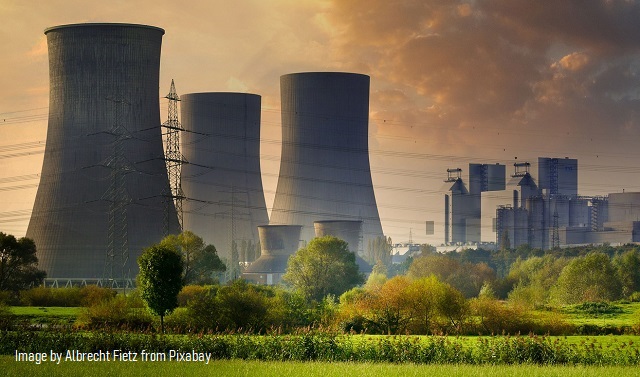Why America Must Go Nuclear—Power That Is!

We keep hearing about the need to dramatically “reduce carbon” in our atmosphere from environmentalists. This means reducing the use of fossil fuels.
So, what is the most effective way to reduce carbon? Why go nuclear.
Let us explain.
According to the Energy Information Administration in 2020 here is where Americans get their power, electricity, from:
- Natural Gas – 39.8%
- Coal – 19.5%
- Nuclear – 18.2%
- Wind – 10.2%
- Hydro – 6.3%
- Solar – 3.4%
- Biomass – 1.3%
- Petroleum – 0.9%
- Geothermal – 0.4%
Americans get 60.2% of their power, electricity, from fossil fuels.
The problem with renewables, particularly solar and wind, is that they aren’t cheap and reliable sources of power, electricity. The wind stops and the sun always goes down. When they do the backup power for these so called “renewables” comes from other sources primarily from fossil fuel driven power plants.
Biomass, geothermal and hydro power make up 8% of our power, electricity. While these sources are reliable they can’t fill the bill to power all homes, businesses with cheap and reliable power, electricity.
But there is one power source that can, if we just take the steps needed, provide us with all the clean power we will ever need.
America Must Go Nuclear
Nuclear energy provides nearly one-fifth of U.S. electricity.
What if all of America’s energy, electricity, came from nuclear power plants?
According to the U.S. Nuclear Regulatory Commission we currently have 95 nuclear power plants licensed to operate.
The USNRC reports, “An operating nuclear power reactor is designed to produce heat for electric generation. Power reactors are distinguished from nonpower reactors which are reactors used for research, training, and test purposes, and for the production of radioisotopes for medical, industrial, and academic uses.”
The Columbia Climate School’s Renee Cho on November 23rd, 2020 wrote,
Nuclear power is the second largest source of clean energy after hydropower. The energy to mine and refine the uranium that fuels nuclear power and manufacture the concrete and metal to build nuclear power plants is usually supplied by fossil fuels, resulting in CO2 emissions; however, nuclear plants do not emit any CO2 or air pollution as they operate. And despite their fossil fuel consumption, their carbon footprints are almost as low as those of renewable energy. One study calculated that a kilowatt hour of nuclear-generated electricity has a carbon footprint of 4 grams of CO2 equivalent, compared to 4 grams for wind and 6 grams for solar energy — versus 109 grams for coal, even with carbon capture and storage.
In the last 50 years, nuclear energy has precluded the creation of 60 gigatons of carbon dioxide, according to the International Energy Agency. Without nuclear energy, the power it generated would have been supplied by fossil fuels, which would have increased carbon emissions and resulted in air pollution that could have caused millions more deaths each year.
Around the world, 440 nuclear reactors currently provide over 10 percent of global electricity. In the U.S., nuclear power plants have generated almost 20 percent of electricity for the last 20 years.
The World Nuclear Association (WNA) in May 2023 reported,
-
- Nuclear power capacity worldwide is increasing steadily, with about 60 reactors under construction.
- Most reactors on order or planned are in the Asian region, though there are major plans for new units in Russia.
- Significant further capacity is being created by plant upgrading.
- Plant lifetime extension programmes are maintaining capacity, particularly in the USA.
Today there are about 440 nuclear power reactors operating in 32 countries plus Taiwan, with a combined capacity of about 390 GWe. In 2021 these provided 2653 TWh, about 10% of the world’s electricity.
The Bottom Line
America must get on the nuclear power bandwagon.
The WNA reported, “Many countries with existing nuclear power programmes either have plans to, or are building, new power reactors. Every country worldwide that has operating nuclear power plants, or plants under construction, has a dedicated country profile in the Information Library. About 30 countries are considering, planning or starting nuclear power programmes (see information page on Emerging Nuclear Energy Countries).”
The USA is the world’s largest producer of nuclear power, accounting for more than 30% of worldwide nuclear generation of electricity, according to the WNA.
Time to build back better with more and more nuclear power plants until the United States gets 100% of its electricity from nuclear power plants.
This will allow the U.S. to become a world exporter of oil, natural gas and coal.
In addition, America will become independent of all foreign sources of energy.
This must be the goal of every administration—energy independence.
©2023. Dr. Rich Swier. All rights reserved.
RELATED ARTICLES:
ESG-compliant firms cause more carbon emissions, says report
The push-back against Net Zero
Unit 3 at Georgia Nuclear Plant Reaches 100% Power Output
Finland’s New Reactor is Already Lowering Electricity Prices
Does Nuclear slow down the scale-up of Wind and Solar? France and Germany can’t agree
Green Cars, Red Ink: Ford Set to Lose $4.5 Billion on Electric Vehicles This Year


Leave a Reply
Want to join the discussion?Feel free to contribute!